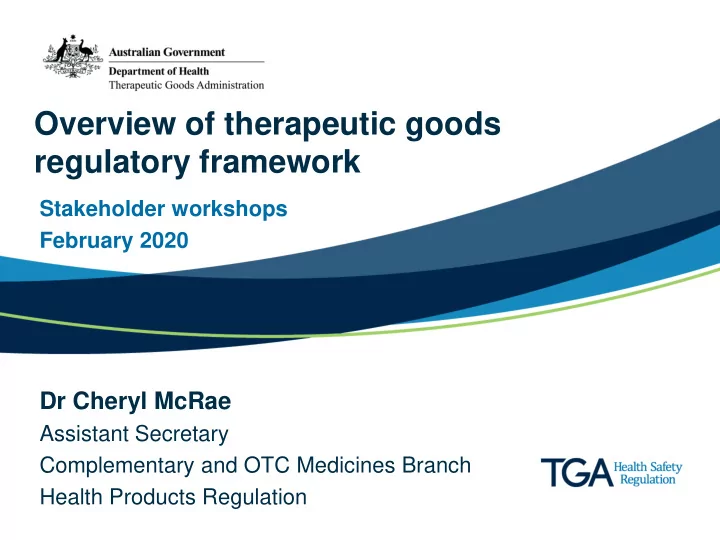

Overview of therapeutic goods regulatory framework Stakeholder workshops February 2020 Dr Cheryl McRae Assistant Secretary Complementary and OTC Medicines Branch Health Products Regulation
Regulation Therapeutic Goods - medicines • Regulated under the Therapeutic Goods Act 1989 and underpinning legislative documents • Unless exempt, medicines supplied in Australia must be included in the Australian Register of Therapeutic Goods ( ARTG ) • ‘ Sponsor ’ – is the person legally responsible for the medicine in Australia • There is a two-tiered risk based system for the regulation of medicines: – higher risk medicines are registered in the ARTG - AUST R – lower risk medicines are listed in the ARTG - AUST L or AUST L(A) 1
Types of listed and registered medicines LISTED MEDICINES REGISTERED MEDICINES Complementary medicines Over-the-counter medicines Prescription medicines High risk Low risk 2
ARTG entry pathways for complementary medicines 3
Good Manufacturing Practice • All medicines , unless exempt, MUST be manufactured under the principles of GMP • Australian manufacturers must hold a GMP licence • Overseas manufacturers must hold GMP clearance certificate 4
Listed medicines - permitted ingredients • List of low risk ingredients that have been pre- approved by the TGA. • Included in the Permissible Ingredients Determination . • Ingredients may have restrictions, such as: – concentration limits – route of administration – plant parts – type of preparation – container type – warning statements 5
Listed medicines - permitted indications • All permitted indications and their requirements are contained in the Permissible Indications Determination – an exclusive list • Additions by application against legislated criteria 6
Indication - risk classification for complementary medicines Listed medicines (AUST L) Assessed listed medicines Registered medicines (AUST L(A)) (AUST R) Low level indications that only Indications that are not appropriate Indications that refer to the refer to: prevention, alleviation or cure for permitted indications, but are not high level indications. of a serious form of a disease, • health enhancement ailment or injury (i.e. restricted • health maintenance Intermediate level indications may representations). • prevention of dietary refer to: deficiency • the prevention, alleviation, or • a disease, ailment, defect cure of a non-serious disease, or injury other than a ailment, defect or injury serious form of those • restricted representations (i.e. a diseases serious form of a disease) Lower risk Higher risk
Evidence for listed medicines - AUST L • Sponsor must hold evidence for all indications and claims at the time of listing and keep their evidence up-to-date. • The Guidelines on the evidence required to support indications for listed complementary medicines provide information for sponsors on: – types of indications and appropriate evidence sources – quality and credibility of evidence – how to present evidence. • A medicine can be cancelled from the ARTG if a sponsor is found to not hold evidence for their medicine’s indication and claims. 8
Evidence required for assessed listed medicines – AUST L(A) • Assessment of efficacy data is based on the finished product (rather than active ingredients in isolation) and include a detailed evaluation of evidence to support all indications and claims . • Only products supported by quality scientific evidence of efficacy will be accepted for assessment through this pathway. • Guidelines on the evidence requirements are available on TGA website. 9
TGA post market monitoring Risk based regulatory approach includes: – desk-based audits of listed medicines – compliance reviews – laboratory testing of products and ingredients – monitoring of adverse reactions – recalls – audit of manufacturing sites – pharmacovigilance monitoring – advertising monitoring 10
Advertising of medicines to the general public • Therapeutic goods are subject to special advertising requirements beyond those required for everyday consumer goods (e.g. refrigerators, televisions) • Regulated by the TGA through the Therapeutic Goods Advertising Code • Advertising must be balanced and only contain claims that the advertiser or sponsor has established are supported by appropriate evidence • Some goods cannot be advertised to the public e.g.: – illegal therapeutic goods – prescription medicines – some pharmacist-only medicines • The TGA is responsible for handling advertising complaints 11
Recommend
More recommend